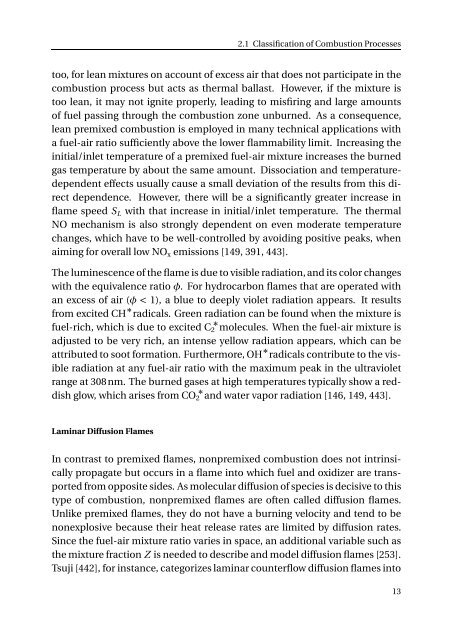On the Formation of Nitrogen Oxides During the Combustion of ...
On the Formation of Nitrogen Oxides During the Combustion of ...
On the Formation of Nitrogen Oxides During the Combustion of ...
Create successful ePaper yourself
Turn your PDF publications into a flip-book with our unique Google optimized e-Paper software.
2.1 Classification <strong>of</strong> <strong>Combustion</strong> Processes<br />
too, for lean mixtures on account <strong>of</strong> excess air that does not participate in <strong>the</strong><br />
combustion process but acts as <strong>the</strong>rmal ballast. However, if <strong>the</strong> mixture is<br />
too lean, it may not ignite properly, leading to misfiring and large amounts<br />
<strong>of</strong> fuel passing through <strong>the</strong> combustion zone unburned. As a consequence,<br />
lean premixed combustion is employed in many technical applications with<br />
a fuel-air ratio sufficiently above <strong>the</strong> lower flammability limit. Increasing <strong>the</strong><br />
initial/inlet temperature <strong>of</strong> a premixed fuel-air mixture increases <strong>the</strong> burned<br />
gas temperature by about <strong>the</strong> same amount. Dissociation and temperaturedependent<br />
effects usually cause a small deviation <strong>of</strong> <strong>the</strong> results from this direct<br />
dependence. However, <strong>the</strong>re will be a significantly greater increase in<br />
flame speed S L with that increase in initial/inlet temperature. The <strong>the</strong>rmal<br />
NO mechanism is also strongly dependent on even moderate temperature<br />
changes, which have to be well-controlled by avoiding positive peaks, when<br />
aiming for overall low NO x emissions [149, 391, 443].<br />
The luminescence <strong>of</strong> <strong>the</strong> flame is due to visible radiation, and its color changes<br />
with <strong>the</strong> equivalence ratio φ. For hydrocarbon flames that are operated with<br />
an excess <strong>of</strong> air (φ < 1), a blue to deeply violet radiation appears. It results<br />
from excited CH ∗ radicals. Green radiation can be found when <strong>the</strong> mixture is<br />
fuel-rich, which is due to excited C 2<br />
∗ molecules. When <strong>the</strong> fuel-air mixture is<br />
adjusted to be very rich, an intense yellow radiation appears, which can be<br />
attributed to soot formation. Fur<strong>the</strong>rmore, OH ∗ radicals contribute to <strong>the</strong> visible<br />
radiation at any fuel-air ratio with <strong>the</strong> maximum peak in <strong>the</strong> ultraviolet<br />
range at 308 nm. The burned gases at high temperatures typically show a reddish<br />
glow, which arises from CO 2<br />
∗ and water vapor radiation [146, 149, 443].<br />
Laminar Diffusion Flames<br />
In contrast to premixed flames, nonpremixed combustion does not intrinsically<br />
propagate but occurs in a flame into which fuel and oxidizer are transported<br />
from opposite sides. As molecular diffusion <strong>of</strong> species is decisive to this<br />
type <strong>of</strong> combustion, nonpremixed flames are <strong>of</strong>ten called diffusion flames.<br />
Unlike premixed flames, <strong>the</strong>y do not have a burning velocity and tend to be<br />
nonexplosive because <strong>the</strong>ir heat release rates are limited by diffusion rates.<br />
Since <strong>the</strong> fuel-air mixture ratio varies in space, an additional variable such as<br />
<strong>the</strong> mixture fraction Z is needed to describe and model diffusion flames [253].<br />
Tsuji [442], for instance, categorizes laminar counterflow diffusion flames into<br />
13
















